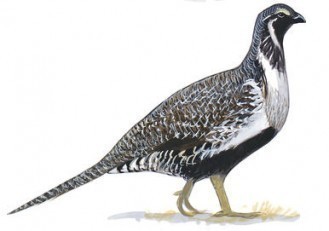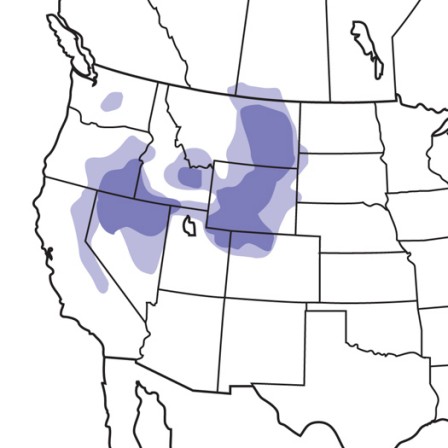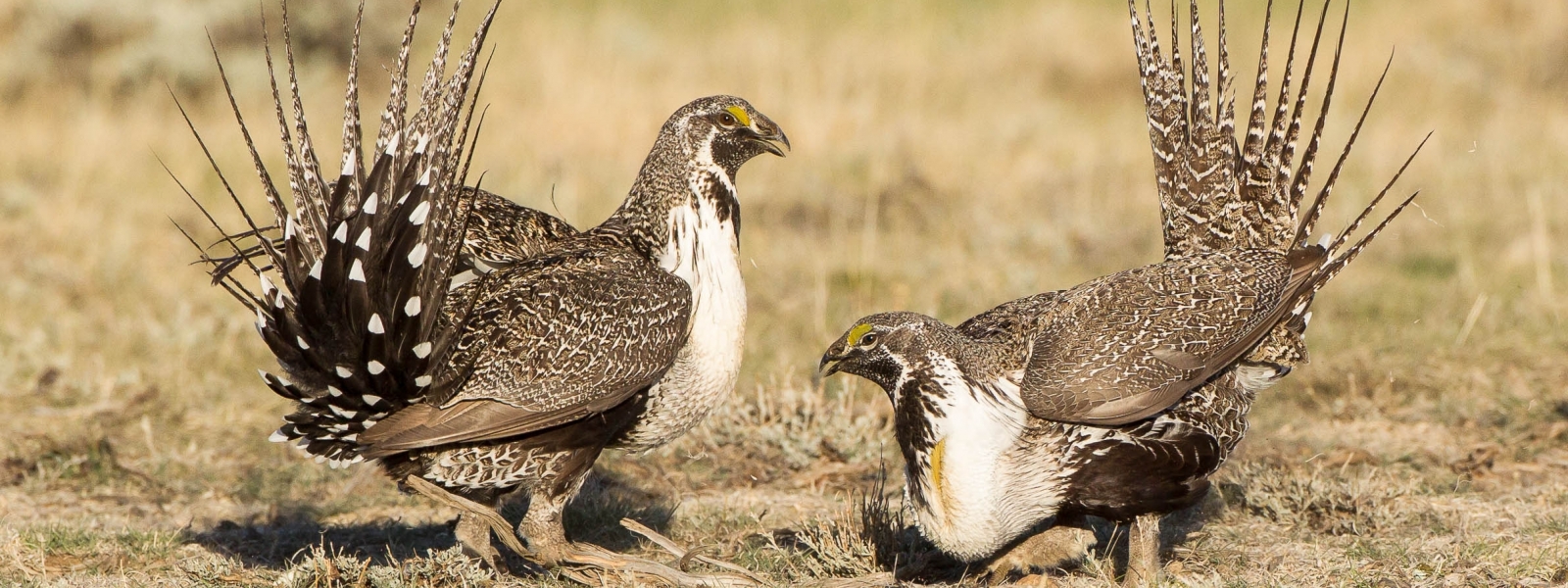Greater Sage-Grouse
Centrocercus urophasianus

Conservation status
Has disappeared from much of former range. Loss of habitat (through clearing for farmland and overgrazing) is one major cause. Threatened by energy development and the effects of invasive plants in much of its remaining range.
Family
Pheasants and Grouse
Habitat
Sagebrush plains; also foothills and mountain slopes where sagebrush grows. Found on open plains, high valleys, rocky mesas, mountainsides, but only in vicinity of sagebrush. Prime nesting habitat includes some lower wet areas where young can forage for insects. In very dry country, may fly several miles to a source of water in morning and evening.
Well-named, this very large grouse is found nowhere except in sagebrush country of the west. It nests on the ground among the sage, and the leaves of this plant are its staple diet in winter. The Sage Grouse is best known for the spectacular courtship displays of the males: Large numbers (up to 70 or more) will gather in spring on traditional dancing grounds and strut with their chests puffed out and spiky tails spread, hoping to attract females.
Feeding Behavior
Forages by walking on ground, browsing leaves and other plant parts, or picking up items from ground.
Eggs
Usually 7-9, sometimes 6-13. Olive-buff, evenly dotted with brown. Incubation is by female only, 25-27 days. Young: Downy young leave nest shortly after hatching. Young are tended by female, but feed themselves. Able to make short flights at age of 1-2 weeks, but do not reach adult size until much later.
Young
Downy young leave nest shortly after hatching. Young are tended by female, but feed themselves. Able to make short flights at age of 1-2 weeks, but do not reach adult size until much later.
Diet
Mostly sage leaves and buds, also insects. Diet in fall and winter may be almost entirely the leaves and fresh shoots of sagebrush. At other seasons, also eats leaves, flowers, and buds of a wide variety of plants; also some insects in summer (young eat many insects at first). Unlike most grouse, digestive system is not adapted for digesting hard seeds.
Nesting
Traditional display grounds may be used for years. In courtship display, male puffs out white chest, inflates two yellow air sacs, raises and spreads tail, droops wings; head is thrown back on shoulders as air sacs are deflated with loud popping sound. Females visit display ground to mate with one of the males. Oldest and most experienced males compete for positions at center of display ground, and these males are usually chosen by females. Nest site is on ground, under sagebrush or clump of grass. Nest (built by female) is shallow depression, sparsely lined with plant material.
Range

Greater Sage-Grouse is an indicator species. This iconic bird is used to infer the relative health of the sagebrush ecosystem which includes the over 350 species of plants and animals like the elk, the pygmy rabbit, the sagebrush lizard and the mule deer, that share it. The mating dance of the Sage-Grouse makes it particularly easy to reliably track and count these birds.
Greater Sage-Grouse numbers are in dramatic decline due to invasive species (primarily cheatgrass), wildfires (primarily fueled by cheatgrass), mining and oil and gas drilling. For example since 2002, the Greater Sage-grouse population has declined by half in Montana.
In 2015, four states – Montana, Wyoming, Nevada and Colorado -- crafted a plan along with the federal government (Bureau of Land Management) to protect the Sage-grouse. It banned mineral mining across 10 million acres of sage-grouse habitat and restricted oil and gas leasing in 13,000 square miles of the most critical habitat areas. The effort involved the participation of conservationists, sportsmen, representatives of ranching and the energy industries and government officials. It was hailed as the largest, most complex land conservation effort in U.S. history. However, Donald Trump’s administration didn’t enforce the restrictions on oil and gas leasing, and it cancelled the ban on mining in a number of areas. In fact, the Trump administration reversed course in December 2017 by issuing an Instruction Memorandum, which allowed of leasing on land that was supposed to be protected by the 2015 plan. Leasing skyrocketed with a 10-fold increase. Consequently Sage-Grouse numbers have been plummeting.
A lawsuit was filed by Earthjustice, on behalf of Montana Wildlife Federation, the Wilderness Society, National Audubon Society, National Wildlife Federation and Montana Audubon. In May 2020, the U.S. District Court in Montana struck down the basis of the Trump administration’s massive oil and gas leasing plans on more than one million acres of public lands in key Sage-Grouse habitat. The Court finding invalidated hundreds of oil and gas leases on federal land in Montana and Wyoming.
“This ruling is a much-needed check on the Trump administration’s relentless effort to advance oil and gas development at the expense of important wildlife habitat and the future of our climate,” said Bruce Pendery, litigation and energy policy specialist for The Wilderness Society. “This administration’s continued attempts to develop oil and gas in Sage-Grouse habitat is an insult to the years of expert scientific analysis and valued stakeholders who have demanded the sage-grouse be left alone.”
Watch this video "Sage-Grouse Explained"
Watch "Cheatgrass in Sagebrush Country: Fueling Severe Wildfires"

